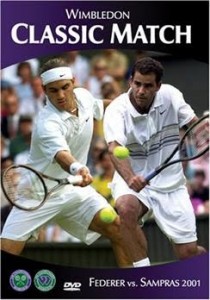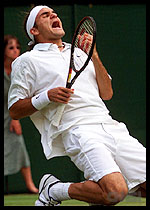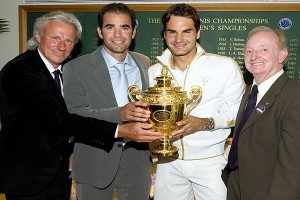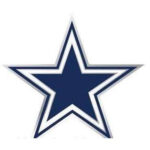Reliving the Wimbledon Classic: Roger Federer Vs. Pete Sampras 2001
Winners are not those who never fail but those who never quit––Edwin Louis Cole
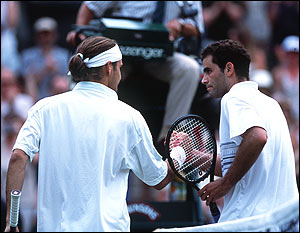
Wimbledon 2001 Federer defeats Sampras in the 4th round. It marked Sampras' earliest exit from the tournament.
If you were lucky, you were there at the inception, when the first moments of brilliance blossomed. The teenage phenom from Switzerland sporting a bandanna, his long hair swept back in a ponytail, bit at his lower lip, serving, dancing along the baseline on Centre Court.
The young challenger waited, seeing the ball as if in slow motion––coiled, poised on the balls of his feet, ready to move forward if the grizzled champion on the other side of the net returned the ball short.
Roger Federer’s main worry centered on containing his own anxiety, of staying in the moment, the point at hand and living each shot as it happened, He could not afford to anticipate beyond the slight movement to the left or the right of the champion, Pete Sampras, who waited on the other side of the net.
From time to time the champion’s serve cracked, blasting through the court, ricocheting off service lines, often beyond the teenager’s ability to lay a racket on it. All the while Sampras sent an unmistakable message that he did not intend to go “gentle into that good night,” as urged by Dylan Thomas, Welsh poet.
Federer’s serve surprised Sampras. Not its speed, but its placement and Federer’s ability to disguise its path, using the same motion regardless of where the Swiss decided to send the ball. His angles, his depth and his movement all worried the defending champion on that afternoon nine years ago.
Sampras whose seemingly languid movements around the court belied his quickness, would turn 30 shortly. The seven-time Wimbledon champion met Federer, 19, on Centre Court at Wimbledon––marking the debut of the man from Switzerland on these esteemed grounds during the fourth round in 2001.
Sampras had not won a tour title since last year’s championship at the All-England Club––almost 12 months ago. He had yet to reach a quarterfinal in a major in 2001. A win this year would tie Sampras with Bjorn Borg at five consecutive Wimbledon Championships.
Coming into Wimbledon, Sampras had won 31 consecutive matches on the green lawns at the All-England Club and he had lost only one match in his last 57. Sampras symbolized Wimbledon––it was his home court where he felt at his most invincible and could deliver the best his game had to offer.
The knock on Federer coming into this match was his inability to do well in the big moments––at the four slams. Coming out of the juniors, Federer was touted to be the next best and greatest. So far, the Swiss failed to live up to his billing and that troubled him, making him try too hard and go for too much.
Federer sought patience because he possessed all the ability, had the requisite foot speed and a deadly arsenal of shots. Maturity needed to be added to the mix. That ingredient he carefully folded into his game as he stood poised on the brink of tennis greatness standing across the net from possibly the greatest of all Wimbledon champions.
Never allowing himself to concentrate on anything other than the point at hand, Federer held on as the first set went to a tiebreak. The teenager moved easily around the court and found himself at the net often, volleying the ball for winners. He didn’t go for too much or try anything more than the moment dictated he do in order to win that point.
During the opening set tiebreak, Sampras held a set point on Federer’s serve––but the Swiss erased the advantage with a service winner and went on to take the first set. Sampras came back strong and took the second set; but Federer broke the American’s serve in the third and closed it out with three consecutive service winners and finally a chalk-kicking ace that sealed the set.
It was at that point that Sampras realized his Wimbledon invincibility, his choke hold on this event was in imminent danger of a potent dismissal. This was no ordinary player across the net and perhaps the defending champion recognized the future in this young man from Switzerland.
Sampras turned up the heat and began firing serves often in excess 136 mph and finding his rhythm at the net. He began to look like the Sampras fans expected to see on Centre Court at Wimbledon. Re-energized, he took the fourth set, evening the contest at two apiece.
The defending champion continued his assault in set five. Finally with the score standing at 4-4, Sampras held two breaks of serve to take him to 5-4, allowing him to serve out the final set.
This proved to be Federer’s defining moment. Holding onto his nerves and never allowing doubt to creep into his psyche, Federer volleyed at that net for a winner to erase one break point then fired a forehand out of reach to pull even, finally holding his own serve.
With Sampras serving at 5-6, for a chance to even the set at 6-6, Sampras fell behind 15-40. Federer, continuing to see the ball well, rifled back a Sampras serve for a winner, taking the set and the match 7-6 (7), 5-7, 6-4, 6-7 (2), 7-5.
As Federer fell to his knees, allowing his emotions finally to surface, Sampras sagged at the full impact of his defeat at the place where he’d enjoyed his greatest victories. The American would never win another championship at Wimbledon.
It symbolized the end of an era with Sampras losing to the man who would serve as the icon of Wimbledon champions for the next era––even though Federer would not win his first Wimbledon title until 2003. At the press conference following his defeat Sampras vowed to return and win another Wimbledon crown. He never did.
As Sampras returned to the sidelines to gather his gear, the applause thundered around him as the crowd recognized the significance of this thrilling, hard-fought match they had just witnessed. Federer with tears in his eyes rejoiced, realizing he had at long last fulfilled the promise of his game.
Sampras, meanwhile, shuffled off the court, recognizing the inevitably of time marching on, pushing him further and further into the history books and out of serious contention. Although Sampras would go on to win another U.S. Open Championship in 2002, retirement remained only months away and perhaps losing this match pointed Sampras toward the door.
Now fast forward to 2010. We see Federer losing in the quarterfinals of the last two majors, pushed aside by lower ranked players, who even a year ago, would not have troubled him. The hurt is especially difficult on the grounds at Wimbledon where Tomas Berdych dismissed the mighty Swiss, marking the first time in the last eight years that Federer will not appear in the Wimbledon Championship final.
The question remains––the subject of endless and pointless debate––is this the end for Federer? Will Tomas Berdych be the next long-running Wimbledon Champion? Perhaps not Berdych but who then?
Soon to be 29, with niggling injuries and an antique racket, time will tell. For his legion of fans, there is no end in sight––just retooling and rest. The best minds feel that Federer must evolve, change his ways in order to stay competitive––in the mix. They have been saying as much for the past three years.
No champion can reign forever. But it is difficult to let go because once you do, you are no longer relevant and you do what you abhor––sit on the sidelines. Ask Bret Favre. Time will tell for Federer but it is safe to say that Federer will make the decision and the rest of us will just have to wait and see…
